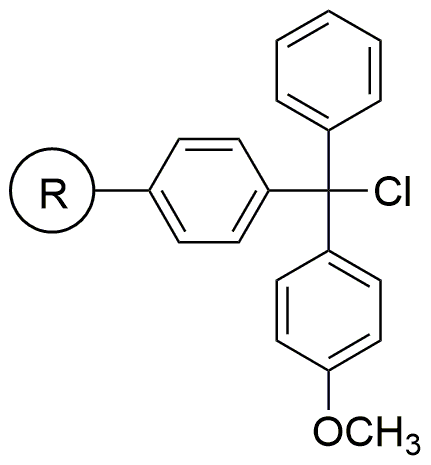4-Methoxytrityl chloride resin is widely utilized in research focused on
- Solid-Phase Synthesis: This resin is essential in the solid-phase synthesis of peptides and nucleotides, allowing for efficient and controlled assembly of complex molecules.
- Protecting Group Applications: It serves as a protecting group for hydroxyl and amine functionalities during organic synthesis, enhancing the selectivity and yield of reactions.
- Drug Development: In pharmaceutical research, it aids in the synthesis of drug candidates by facilitating the formation of specific molecular structures, streamlining the drug discovery process.
- Bioconjugation: The resin is used in bioconjugation techniques, where it helps attach biomolecules to surfaces or other molecules, crucial for developing diagnostics and therapeutics.
- Custom Polymer Development: Researchers leverage this resin for creating custom polymers with tailored properties, which can be applied in various fields, including materials science and nanotechnology.
General Information
Properties
Safety and Regulations
Applications
4-Methoxytrityl chloride resin is widely utilized in research focused on
- Solid-Phase Synthesis: This resin is essential in the solid-phase synthesis of peptides and nucleotides, allowing for efficient and controlled assembly of complex molecules.
- Protecting Group Applications: It serves as a protecting group for hydroxyl and amine functionalities during organic synthesis, enhancing the selectivity and yield of reactions.
- Drug Development: In pharmaceutical research, it aids in the synthesis of drug candidates by facilitating the formation of specific molecular structures, streamlining the drug discovery process.
- Bioconjugation: The resin is used in bioconjugation techniques, where it helps attach biomolecules to surfaces or other molecules, crucial for developing diagnostics and therapeutics.
- Custom Polymer Development: Researchers leverage this resin for creating custom polymers with tailored properties, which can be applied in various fields, including materials science and nanotechnology.
Documents
Safety Data Sheets (SDS)
The SDS provides comprehensive safety information on handling, storage, and disposal of the product.
Product Specification (PS)
The PS provides a comprehensive breakdown of the product’s properties, including chemical composition, physical state, purity, and storage requirements. It also details acceptable quality ranges and the product's intended applications.
Certificates of Analysis (COA)
Search for Certificates of Analysis (COA) by entering the products Lot Number. Lot and Batch Numbers can be found on a product’s label following the words ‘Lot’ or ‘Batch’.
*Catalog Number
*Lot Number
Certificates Of Origin (COO)
This COO confirms the country where the product was manufactured, and also details the materials and components used in it and whether it is derived from natural, synthetic, or other specific sources. This certificate may be required for customs, trade, and regulatory compliance.
*Catalog Number
*Lot Number
Safety Data Sheets (SDS)
The SDS provides comprehensive safety information on handling, storage, and disposal of the product.
DownloadProduct Specification (PS)
The PS provides a comprehensive breakdown of the product’s properties, including chemical composition, physical state, purity, and storage requirements. It also details acceptable quality ranges and the product's intended applications.
DownloadCertificates of Analysis (COA)
Search for Certificates of Analysis (COA) by entering the products Lot Number. Lot and Batch Numbers can be found on a product’s label following the words ‘Lot’ or ‘Batch’.
*Catalog Number
*Lot Number
Certificates Of Origin (COO)
This COO confirms the country where the product was manufactured, and also details the materials and components used in it and whether it is derived from natural, synthetic, or other specific sources. This certificate may be required for customs, trade, and regulatory compliance.


